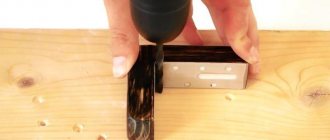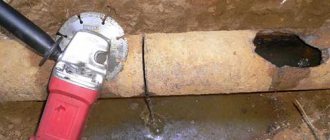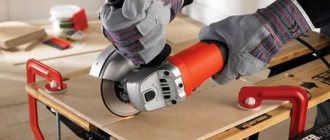For carpenters, boards and beams are the most common blanks, from which crafts and wood products are subsequently produced. And the first thing the material undergoes is sawing into pieces of the required length. At the same time, you should know how to saw off a board evenly, because performing this operation incorrectly can ruin the workpiece or significantly affect the appearance, and not for the better.
At large enterprises, the problem of how to saw off a beam or board evenly does not arise. Any serious production facility has high-precision equipment that performs this type of work. At home you have to make do with what you have on hand. At the same time, you still need to be able to use the tool or equipment correctly in order to saw off the board correctly, and the cut turns out without flaws.
Note that many enterprises that sell boards and timber provide cutting services. And for this they use the same specialized equipment, so the purchased material will be cut with high quality. But it is not always possible to use such a service, and it often happens that only one piece needs to be cut.
How to use a hand saw
The saw needs to be driven, otherwise it will start “walking”.
This must be taken literally. Wood is a living material, and its behavior is unpredictable. Hard growth rings, knots, cracks, high humidity and high resin content can seriously complicate sawing. For this reason, there is no universal tool that can take into account all the vagaries of wood, but there are many different special saws. The shape and order of alternation of their teeth are determined not by the material from which the saw blade is made, but by its purpose. Some tools can only be cut in a straight line, while others, on the contrary, are better able to cut in a circle.
When sawing, only the saw moves; the workpiece must be securely fastened. Therefore, you will need stable support. For example, a workbench or sawhorses. The workpiece is secured with a clamp or held by hand, and especially large ones - additionally with a knee.
Sawing begins and ends with repeated light pulling of the saw in the opposite direction, that is, a “trace” is laid. At the end of sawing, you must hold the remainder firmly so that it does not break off along with the piece of main wood.
Sawing is one of the most common processes in wood processing. A clean, even cut is not a problem if you choose the right tool and know how to use it.
In the photo (from top to bottom): large and small hacksaws; saw with a “back”; saw with a narrow blade. Next to the left is a saw for finishing cutting.
Tsulaga
When processing small workpieces, the tsulaga shown in the pictures below can be of great help.
To make it, you will need a piece of wood slab approximately 20 x 30 cm in size and 2 mm thick, as well as two planed strips, which must be fixed to the slab as shown in the figure. To prevent the slab from bending and breaking, the planks must be positioned transverse to the direction of its core layer.
How to work with a circular saw
The lower bar of the tsulaga rests against the edge of the tabletop and thus sets the correct direction for the cut; the shortened upper bar ensures good centering of the saw.
If you have to saw long boards or planks, then a second tsulaga will not hurt, which will serve as a stop for the other end of the workpiece.
A piece of wood slab and two pieces of plank are enough to make a practical tsulagi.
Before starting sawing, the saw placed at an angle must be pulled towards you several times.
Adhesive tapes
To protect the back side of the plywood, tape is applied along the cutting line. This method helps prevent large pieces from breaking off, which is especially effective if you decide to use a manual or electric jigsaw. However, not every adhesive tape is suitable for these purposes. For example, masking tape in this case will be completely useless due to its small safety margin.
Before you start sawing , tape with fiberglass or aluminum reinforcement is glued to the surface. The requirements for its width are as follows: there should be a margin of 1.5-2.0 cm on both sides of the cutting line. It is better to paste by pressing the tape with a dry cloth, preventing the formation of wrinkles and gluing.
After the saw blade or electric jigsaw has stopped working, you should remove the tool, first unplugging it from the power supply. Then start peeling off the tape. In this case, great care should be taken so that sudden movements do not cause the tearing of small fragments of the laminated surface that inevitably form during cutting. Therefore, it is necessary to abandon the use of materials with a strong adhesive base. When choosing such a tape, you should take into account its adhesive ability and ease of cleaning from rough surfaces.
Top best circular saws
| Place | Model | ||
| 1. | Makita 5008MG, 1800 W | Prices | Review |
| 2. | BOSCH GKS 190, 1400 W | Prices | Review |
| 3. | Makita HS7601, 1200 W | Prices | Review |
| 4. | BISON PD-65, 1600 W gray | Prices | Review |
| 5. | VORTEX DP-160/1200, 1200 W orange | Prices | Review |
| 6. | Interskol DP-190/1600M, 1600 W | Prices | Review |
| 7. | BOSCH GKS 600, 1200 W | Prices | Review |
| 8. | BOSCH PKS 40 2015, 850 W | Prices | Review |
| 9. | Makita HS7601K, 1200 W | Prices | Review |
| 10. | Makita HS7600, 1200 W | Prices | Review |
Can I cut with a jigsaw?
The tool is suitable for making small cuts. You will need a tool for working with metal, with fine teeth. The cut is made along the front side: this way there will be fewer chips on it, and there will be small irregularities on the back side.
When working with a jigsaw, the cut is made from the reverse side due to the direction of the teeth on the file.
When working, the tool is not set to maximum speed, but slightly above average. The tool must be moved with smooth movements, with light pressure.
Important! The method is not suitable for cutting long materials, since it is difficult to maintain an even cut line.
Long sawing technique
The most difficult stage of the process is making the first cut. To do this you need:
- install a leading ruler, which consists of two boards that are fastened together at an angle of 90 degrees;
- after this, it is necessary to place the sawn log on the supports and fix it;
- then it is important to check whether the log is level;
- at the next stage it is necessary to secure the leading ruler to the supports using self-tapping screws;
- After this, you can start creating the first cut.
Types of working attachments
When sawing logs with a chainsaw, various attachments are used.
- Attachment for longitudinal sawing. Used for sawing logs lengthwise , the process takes place in a horizontal position. After work, the master receives the same thickness of the product. The finished materials undergo a drying process, after which the boards are used in construction. In appearance, the device is a small frame; it is attached to the tire on each side.
- Drum debarker (debarker). With the help of such an attachment it is easy to dissolve the log; it works due to a V-belt drive. Attached to belts on both sides, special pulleys are used for this. The speed of rotation of the shaft depends on the size of the pulleys, so the performance of the attachment is easy to change. This technology forces the master to carefully monitor each stage of the process; some specialists use an assistant during this cutting. But this option requires increased security measures.
- Sawing with a lightweight nozzle. The method is not very productive, but is used quite often. The element is fastened on one side, but the workpieces are slightly uneven. Such materials are necessary for the construction of sheds or fences.
Chainsaw device classes
Currently, all chainsaws on the Russian market can be divided into three main classes:
- Conventional household devices that are designed for simple work. These chainsaws do not have much power, and do their job perfectly. With the help of these chainsaws, you can easily prepare firewood for a bathhouse or cut down an unnecessary tree. And the capabilities of such saws are easily compensated by their low weight and convenient control.
- Semi-professional chainsaws designed for any work, from repair and construction activities to felling of timber.
But such saws have one drawback. They cannot be used for eight hours a day. Because of this, they are called semi-professional. These devices are usually used by lumberjacks to trim knots. - Professional chainsaws specialize in wood cutting. Their operating time ranges from 10 to 16 hours a day and these saws can be used for seven hours without stopping.
Circular saw – high performance and ease of use
A circular saw is the best option for performing the work. It has excellent productivity and allows you to cut a considerable number of workpieces in a relatively short time, and with high quality. In addition, such a saw allows you to make a longitudinal cut of the material, but you need to know how to cut the board straight along .
One of the most important criteria when choosing a circular saw is the maximum depth of cut. There are devices on the market that cut materials with a thickness of 30 to 130 mm. That is, you can choose a machine both for cutting only thin boards and for sawing bars.
It is also worth paying attention to the cutting tool itself. Discs with a large number of teeth will provide a neat, high-quality cut, while the cutting speed will be low.
How to cut a board straight
How smart and quick-witted our people are!
Sergey Burkov:
How to unravel a 3-meter board so that both resulting halves are, for example, 10 mm thick
BANDIT#:
you explain it like to schoolchildren, with a countersunk head, etc.
Alex Lobo:
Eco miracle.
COMPUTER:
What if the board is 2 meters long? How are you going to put it on your butt?
Nikolay Sitkov:
Ha, I wasn’t smart enough to use a hacksaw, although I’ve encountered this problem more than once. That’s a good point.
HOW TOO?:
Christmas trees, watch your fingers, bro. I wouldn't do that)))
Workshop on the balcony:
Simple, cheap and cheerful :))). Like
Mike VIZ:
Hello, you have already seen this circular in your frame several times. Is it AEG or another company? Maybe you can do a review, I’m choosing a saw for myself, I’d like to hear advice from an experienced person on what to pay attention to.
Andrey Ivanov:
Liked. Like.
Hacksaw - simplicity and safety
A hacksaw is a simple tool that is quite suitable for the job. And although the cutting speed is low and considerable physical effort is required, such a saw is the most acceptable option for home use.
to cut wood correctly The main condition for a high-quality cut of the material is to make the cut correctly. To simplify the task, you can use a regular flat block, which is used as a guide.
The question often arises of how smoothly with a hacksaw at an angle. For this purpose, a special carpentry device is used - a miter box. Moreover, it will help not only to make a cut at the desired angle, but will also allow any beginner smoothly .
You can also saw off the timber with a hacksaw. The only problem when working with such a workpiece is that you have to put in a lot of effort.
The last option is to use an angle grinder with a wheel with teeth installed for the work. But since the “grinder” is not intended for cutting wood, this method can only be used as a last resort: attempts to cut a board can result in serious consequences. It’s better to use a hacksaw - it’s labor-intensive, but safe.
All my life will now take place in my VKontakte group, https://vk.com/club37090442 here I only post videos, without discussions or comments.
Serge_msv:
Well damn…
Mila Solovyova:
exciting film. Myocardial infarction!!)))) (according to TO) And so - super!! Thank you!
Sawing technology
It may seem to some that sawing a log into boards at home is as easy as shelling pears. But this is a wrong judgment, especially when it comes to the production of building material for the construction of any structure.
Before dissolving the log, it is necessary to decide what size the lumber should be and what quality the final boards should have. The choice of a suitable tool depends on these factors.
The main phase of dissolution must be started only after inspecting the logs. You may need to remove bark and knots from them. If the logs do not have any flaws or defects, the processing process will go much faster, and the final lumber will exceed all the expectations of the master.
Today, there are several types of cutting logs, depending on the orientation of the growth rings of the felled tree.
- Radial . In this case, the cut must be made along the radius of the growth rings. The finished lumber will meet high quality requirements and will not deform even after long-term use.
- Tangential . This variety involves sawing the log tangentially relative to the growth rings. However, the resulting lumber will not have the desired strength.
- Parallel . The most understandable cutting option occurs parallel to the grain of the wood.
When unraveling logs in the direction of the grain, it is best to use the roundwood option. Initially, the round timber slab is cut off from the 1st side part. Then the log is turned over 180 degrees, and the 2nd croaker is removed.
In order for the boards to be even, the processed log must be constantly turned over.
Regardless of the chosen method of cutting different logs, it is necessary to adhere to several general rules that correspond to the sawing technology.
- The log should not move during processing. It should be securely fastened to the work surface.
- When using a chainsaw, you will need a chain for longitudinal processing so that the cut is smooth and the saw does not go sideways. It is very important that the chain is sharpened and does not sag.
- When cutting with your own hands, you should choose small-sized logs.
- Before you start cutting, you should make markings that correspond to the selected type of cut.
- It is important to pay special attention to safety precautions at any stage of log processing.
Homemade attachments
Masters have long learned to do a lot of things with their own hands. There is a huge variety of frame designs on the Internet that allow a chainsaw to cut logs into boards. There are simple manual options, there are large complexes of a frame and guides, with the help of which the tool moves or the log rises/lowers. One of them is in the video below:
Please note that the structure is assembled from metal profiles, which makes it reliable and stable. At the same time, the machine (it simply cannot be called otherwise) is equipped with mechanical gearboxes that simplify the process of moving the workpiece barrel and the chainsaw. No manual effort, just turn the handle from the gearbox. In this case, the thickness of the boards is adjusted by lifting the log, and not with a gasoline tool.
Another option is an attachment that helps make cuts not in a horizontal plane, but in a vertical one. The design is simple, but it is more difficult to work with because you have to make an effort to hold the chainsaw. In addition to the device, you have to prepare a metal strip or board, which is attached to the log in the longitudinal direction. It is on this that the frame-nozzle rests when cutting is carried out.
In addition, this option is more dangerous, because nothing holds the board being cut. She may hit her leg if she falls. So the process needs to be carried out carefully. The video below clearly shows how this option works.
Another setup that the manufacturer called a carriage. For this purpose, such a frame structure was made from a profile pipe and several wheels, which will give the device some mobility in terms of moving along the workpiece barrel. They are also a kind of stops that do not allow the chainsaw to move from side to side.
READ Mixing proportions of gasoline and chainsaw oil
In addition to the carriage, a regular aluminum ladder is used, which acts as a guide element. It is attached to the log with clamps on nails or screws.
Please note that the width of the ladder must match the distance between the carriage wheels located at its different ends. The staircase must be placed in a horizontal plane using a building level. It is leveled by placing pieces of boards of different thicknesses underneath it.
The prepared chainsaw with the carriage is installed on the stairs. Turn on the engine and push along the workpiece with your hands, cutting off its upper part.
From the side the process is visible better. Here you can see a carriage with wheels, a ladder, a log lying under it, and how the cutting process is carried out.
The design of this type of device is quite complex. But of the many homemade manual options, it is better, more convenient, and more reliable. It became possible to adjust the cutting height horizontally by first installing a ladder along the horizon.
Secrets of cross cutting
A crosscut saw is used to produce firewood or decorative interior elements. Sawing is carried out according to the following principles:
- Place the log in a horizontal position on wooden supports, the height should be 0.5 m.
- Clean it from the bark.
- Using an ax or saw, make small marks along the entire length; they should be located at the same distance from each other.
- Make a cut along the cuts.
Cross cutting does not require the use of special devices or attachments. An ordinary chain is perfect for such work, but its rings must be strong.
Attachment for longitudinal sawing
Used for sawing logs lengthwise , the process takes place in a horizontal position. After work, the master receives the same thickness of the product. The finished materials undergo a drying process, after which the boards are used in construction.
In appearance, the device is a small frame; it is attached to the tire on each side.
Let's consider two methods that suit us: cutting logs lengthwise and crosswise
- Cross cutting is used to produce parts in the form of disks or cylinders.
- And the longitudinal method is used to dissolve logs into boards , beams, and slats. For this purpose, many devices are used in production. We will look at how you can cut a log at home, on your own.
For cutting you can use:
- Circular
- Pilou
- Grinder with attachments
So, we have already removed the bark from the log, so we move on to the next steps:
- We fix the log on the guides or bed
- We saw off the slab on one side to get a smooth surface.
- Turn the log over onto the bed with its flat side and remove the second slab
- Next we cut the log into planks
Another variant
There are a large number of similar attachments on the market. All of them are suitable for sawing logs into boards, they all have a similar design. But there are also differences. The photo below shows accessories for a chainsaw, which does not require additional accessories or tools to operate. In essence, this is a miniature manual sawmill, which is based on a gasoline saw.
The design is complemented by guides and wheels that move along the surface of the log, reducing resistance. There are two pairs of wheels, they are located on opposite sides of the workpiece. It’s convenient, easy, and, on the plus side, the quality of the cut material increases.
The nozzle is attached to the chainsaw in exactly the same way as in the previous case. The main requirement for the work is to accurately install the saw so that it is in a horizontal position. And although the oblique cut turns out the same, it is more convenient and easier when the tool is positioned evenly.
What is the difficulty of using an angle grinder with wood?
The first thing that experts pay attention to is that the blade rotation speed of an angle grinder is much higher than that of a circular saw. Therefore, if you will be cutting not only metal and concrete, but also working with wood, buy an angle grinder with a disc rotation speed controller and soft start.
To cut a log, saw a tree with a grinder or fell a trunk, you need to work at medium speeds - at a high speed of rotation of the nozzle, any obstacle in the path of the cutting edge (wire, nails, resin, clamping the disk, incorrect angle of the disk, multidirectional wood fibers) can provoke a powerful a jerk of the tool, and you may simply not be able to hold the grinder in your hands. In addition, you can cut down a tree on your site using a grinder only by holding it horizontally, and this is a high risk of injury.
Before starting work, determine which side it will be more convenient for you to screw in the handle-holder of the grinder, and at what angle you should turn the protective casing in order to maximally protect your eyes and face from sawdust.
Pre-route the power cable along a safe route and not in the path of a falling tree.
Important! Under no circumstances should you cut a tree trunk or a lying log with a grinder without adjusting the rotation speed of the blade. Also, do not use metal discs, grinding or polishing attachments for this purpose. It is best to use a wood disc with large teeth.
Circular saw – high performance and ease of use
A circular saw is the best option for performing the work. It has excellent productivity and allows you to cut a considerable number of workpieces in a relatively short time, and with high quality. In addition, such a saw allows you to make a longitudinal cut of the material, but you need to know how to cut the board straight along .
One of the most important criteria when choosing a circular saw is the maximum depth of cut. There are devices on the market that cut materials with a thickness of 30 to 130 mm. That is, you can choose a machine both for cutting only thin boards and for sawing bars.
It is also worth paying attention to the cutting tool itself. Discs with a large number of teeth will provide a neat, high-quality cut, while the cutting speed will be low. But discs with a small number of teeth will provide high productivity, but the quality of the cut will also be worse.
Now let's talk about how to cut smoothly with a circular saw. One of the conditions for high-quality performance of work is reliable fixation of the workpiece. If the material is loosely secured, the board may “move” when cutting, and the cut will be uneven.
If the circular saw is hand-held, then all work should be performed on a workbench equipped with stops and guides for workpieces. You can make such a device yourself, using any table as a basis.
Before starting sawing, it is important to set the cutting depth correctly. Some hand saws have an adjustable side guide that can be used to make rip cuts in material. If there is no such device, then use the same workbench.
More convenient in terms of work is a tabletop circular saw, which is already equipped with everything necessary - guides, clamps. Often, such equipment allows you to cut workpieces at an angle.
During the sawing process, it is important not to exceed the force on the tool, otherwise the quality of the cut will be poor, and the increased load on the saw will lead to rapid dulling of the cutting blade.
Do not forget about safety precautions when using such equipment. Work should be carried out only after checking the serviceability of the saw and the correct fastening of the workpiece. Also, do not neglect protective equipment - masks, goggles.
Why does a jigsaw cut crookedly?
In some cases, the craftsman may end up with a crooked cut. This kind of trouble arises due to:
- using a dull file;
- lack of marking line;
- too much pressure on the tool during work.
When working with materials that are too thick, it is difficult to achieve an even cut.
Troubleshooting solutions
To get an acceptable result, you need to be patient and work with the tool correctly. Don't put too much pressure on it or push it forward. This will only worsen the quality of sawing and cause chips to appear on the material. It is important to apply a marking line to the workpiece.
Sawing metal panels, wooden tabletops and other products requires a device with a well-sharpened saw blade.











